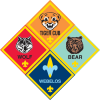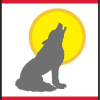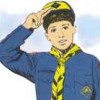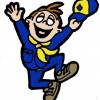 Traveling is one of humankind’s greatest adventures. Early explorers sailed across vast oceans, floated down mighty rivers, and journeyed through high mountain country to see what they could find.
Traveling is one of humankind’s greatest adventures. Early explorers sailed across vast oceans, floated down mighty rivers, and journeyed through high mountain country to see what they could find.
You can be an explorer, too. You won’t be traveling in unknown territory, but it will be new to you. You’ll enjoy the thrill of discovery wherever you travel.
Be curious, ask questions, read signs about points of interest, notice the sights and sounds.
In earning the Traveler activity badge, you’ll learn how to help plan family trips. You’ll also learn how to use public transportation— buses, planes, and trains. Let’s go! When
Requirements
Do five of these:
1. Get a map or timetable from a railroad, bus line, airline, subway, or light rail. The line should serve the place where you live or near where you live. Look up some places it goes.
2. Use a timetable to plan a trip from your home to a city in another state by railroad, bus, airline, or ferry.
3. With the help of your parent, guardian, teacher, or librarian, use a map site on the Internet to plan a trip from your home to a nearby place of interest. Download and/or print the directions and a street map showing how to go from your home to the place you chose.
4. With your parent or guardian, take a trip to a place that interests you. Go by car, bus, boat, train, or plane.
5. Figure out what it costs per mile for the trip you took or planned to fulfill requirement 2, 4, 6, or 7. (Don’t forget to include getting back to your starting point!)
6. Decide on four nearby trips you would like to take with your parents or guardian. Draw the route of each trip on a highway map. Using the map, act as navigator on one of these trips. It should start at your home, be at least 25 miles long, and have six or more turns.
7. Decide on a trip you would like to take that lasts at least two days. Pack everything you would need for that trip.
8. Check the first aid kit in the family car to see if it contains what is needed. Explain what you found.
9. Look at the map legend on a road map of your area. Learn what the symbols mean. Show your den members what you have learned.
10. On a road map of your area, find a place of interest and draw two different routes between it and your home. Use the map legend to determine which route is shorter in miles.
11. Make a list of safety precautions you, as a traveler, should take for travel by each of the following: car, bus, plane, boat, train.
12. While you are a Webelos Scout, earn the Cub Scout Academics belt loop for Geography.
13. While you are a Webelos Scout, earn the Cub Scout Academics belt loop for Map and Compass.






